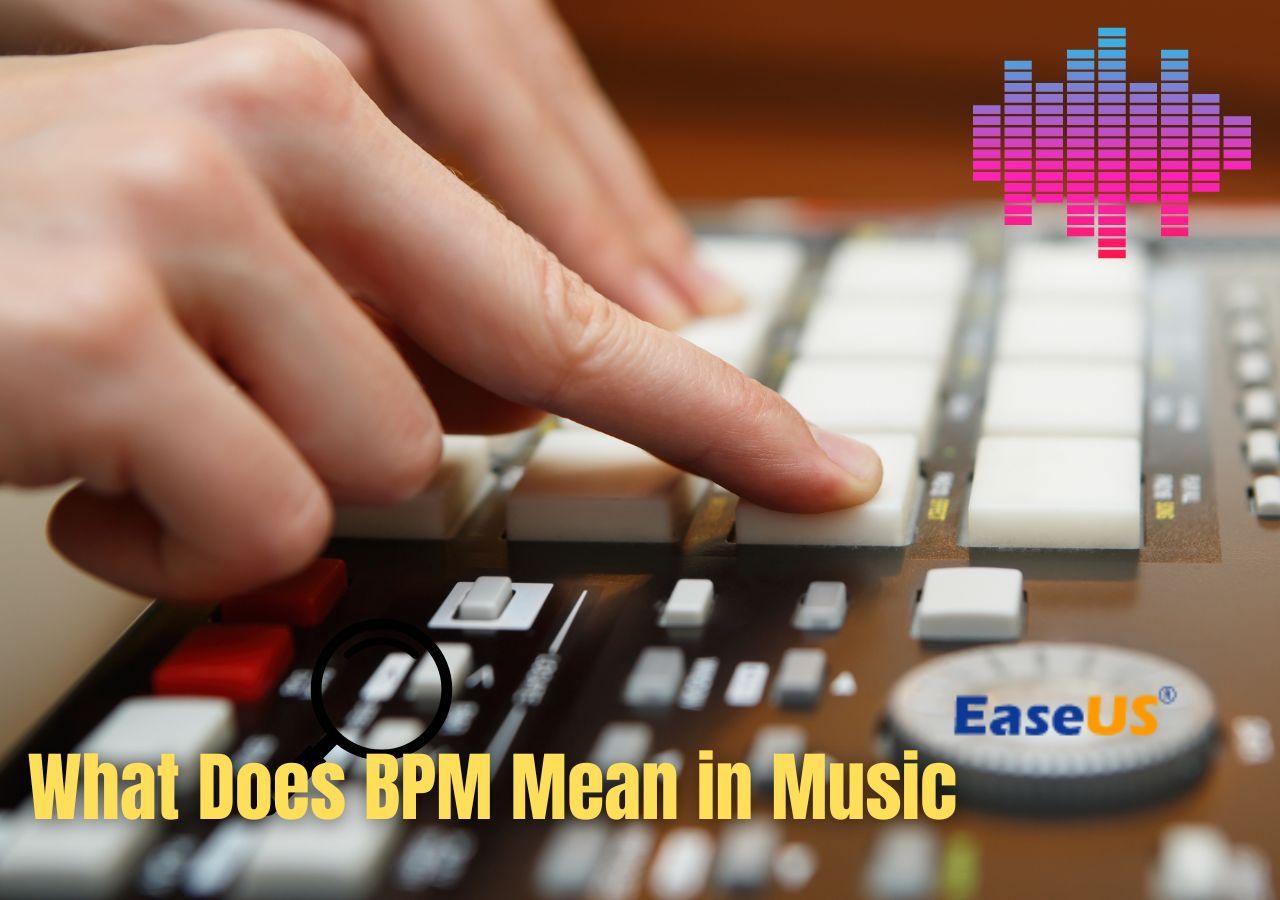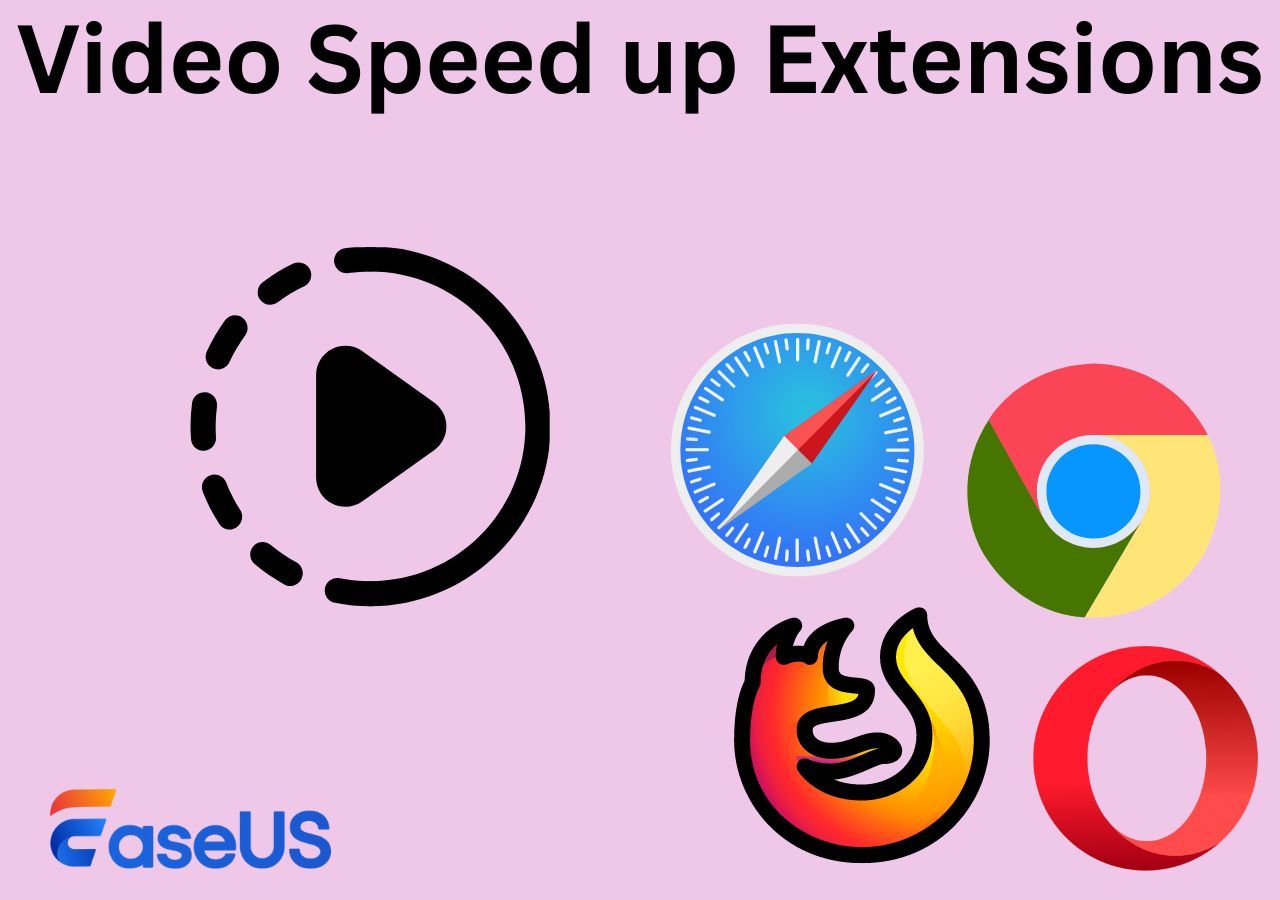-
![]()
Sofia Albert
Sofia has been involved with tech ever since she joined the EaseUS editor team in March 2011 and now she is a senior website editor. She is good at solving various issues, such as video downloading and recording.…Read full bio -
![]()
Melissa Lee
Melissa Lee is a sophisticated editor for EaseUS in tech blog writing. She is proficient in writing articles related to screen recording, voice changing, and PDF file editing. She also wrote blogs about data recovery, disk partitioning, data backup, etc.…Read full bio -
Jean has been working as a professional website editor for quite a long time. Her articles focus on topics of computer backup, data security tips, data recovery, and disk partitioning. Also, she writes many guides and tutorials on PC hardware & software troubleshooting. She keeps two lovely parrots and likes making vlogs of pets. With experience in video recording and video editing, she starts writing blogs on multimedia topics now.…Read full bio
-
![]()
Gorilla
Gorilla joined EaseUS in 2022. As a smartphone lover, she stays on top of Android unlocking skills and iOS troubleshooting tips. In addition, she also devotes herself to data recovery and transfer issues.…Read full bio -
![]()
Rel
Rel has always maintained a strong curiosity about the computer field and is committed to the research of the most efficient and practical computer problem solutions.…Read full bio -
![]()
Dawn Tang
Dawn Tang is a seasoned professional with a year-long record of crafting informative Backup & Recovery articles. Currently, she's channeling her expertise into the world of video editing software, embodying adaptability and a passion for mastering new digital domains.…Read full bio -
![]()
Sasha
Sasha is a girl who enjoys researching various electronic products and is dedicated to helping readers solve a wide range of technology-related issues. On EaseUS, she excels at providing readers with concise solutions in audio and video editing.…Read full bio
Content
Quick Answer
Tempo Ruler Adjustment
Manual BPM Adjustment
Tempo Operations Window
MIDI & Elastic Audio
Tempo Track
Change Tempo Online Quickly
Wrapping up
Change Tempo in Pro Tools FAQs
4048 Views |
4 min read
Quick Answer
To change the tempo in Pro Tools:
▶️Step 1. Access the Transport window.
▶️Step 2. Go to "View" > "Rulers" > "Tempo" to show the tempo ruler.
▶️Step 3. Click the + that says "Add Tempo Change" and type the BPM number here.
Tempo is a song's pulse and one of the key features that helps define a genre. It brings harmony to the song and conveys the emotions about a particular subject. Changing tempo in Pro Tools is a skill musicians must master since it expresses music in a different way.
If you are a video creator looking for a sped-up TikTok song or someone who enjoys singing and wants to put the song that way, you can refer to this article about changing tempo in Pro Tools in 5 methods.
Tempo Ruler Adjustment
The first way is also the most basic method like changing tempo in MuseScore. It provides a tempo map and tempo editor to plan and adjust the tempo markers in detail. This allows for precise control at specific points in the timeline.
However, this method is limited to static tempo changes and, therefore, is not suitable for gradual tempo adjustments.
Anyhow, let's see how to adjust tempo rulers.
Step 1. Access the Transport window.
Shortcut: CMD +1 for Mac, CTRL+1 for Windows.
Step 2. Show the tempo ruler.
Go to "View" > "Rulers" > "Tempo" or click on the ruler area above the tracks to open it.
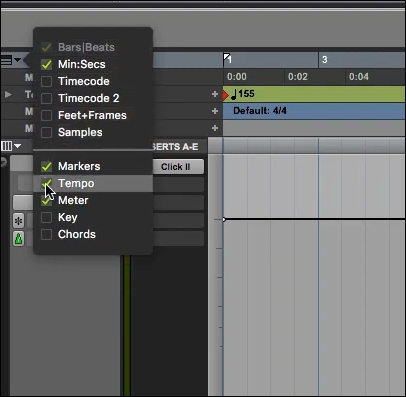
Step 3. Change your tempo.
Click the + that says "Add Tempo Change" and type the BPM number here.

Manual BPM Adjustment
In Pro Tools, manual tempo changes offer a straightforward method to adjust a track's BPM directly from the Transport window. This feature proves invaluable for projects where consistent tempo is desired across all sections.
Users can swiftly implement changes by manually adjusting the tempo, ensuring a seamless rhythmic flow throughout the project.
Here's how to utilize manual tempo changes:
Step 1. Open the Transport window.
Access the Transport window by pressing "Cmd+1" on Mac or "Ctrl+1" on PC. This window displays your session's current tempo.
Step 2. Look for the current BPM.
Within the Transport window, find the tempo field, indicating the current BPM (beats per minute).
Step 3. Change the tempo.
Enable the conductor. Input the new BPM value and press Enter. Your session's tempo will instantly update to the new value.

See also:
Tempo Operations Window
Adjusting tempo isn't all about speeding up a song; for various tempo operations, navigate to the tempo operations window to set a constant tempo, ramp tempo changes, or conform it to match a selection. There are more advanced tempo editing features compared to the tempo ruler. So, it is a perfect choice for projects.
But as it sounds, the process might be tricky for beginners and may overdo the tempo.
Step 1. Find the tempo operations window.
Go up to "Event" > "Tempo Operations" to start the window, or use the shortcut Option+2 (Mac) or Alt+2 (Windows).
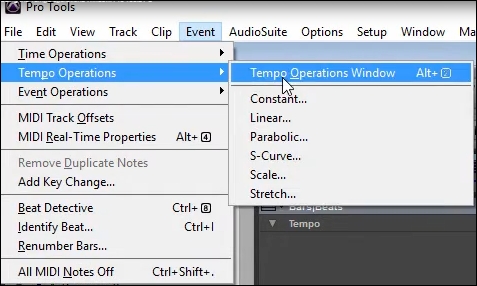
Step 2. Select operations.
Perform various operations such as setting a constant tempo, ramping tempo changes, or conforming the tempo to match a selection.
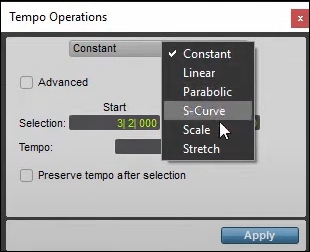
Step 3. Adjust your tempos.
Enter values for tempos and set up relevant parameters. Press "Apply" to automate the tempo changing process.
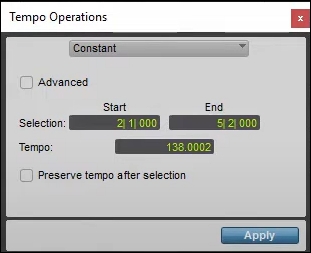
MIDI & Elastic Audio
If you're working with MIDI tracks, you can also embed tempo changes directly into the MIDI data. MIDI controller provides precise control over tempo changes within individual MIDI regions, but this may not be as visually intuitive as with the tempo ruler.
While Elastic audio provides real-time time-stretching capabilities to match project tempo changes, it may degrade audio quality.
Step 1. Set all tracks tick-based.
Hold Option on a Mac or ALT on a PC to resize the tracks to a medium height. Look for the time-based selector on each track and hold the Option key to switch it to "Ticks."
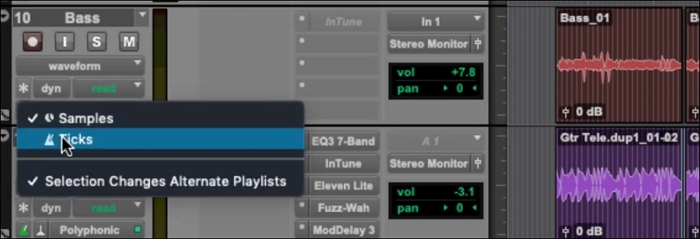
Step 2. Enable elastic audio for all audio tracks.
Click on the broom icon to select Polyphonic (e.g., a chordal instrument guitar, piano keys, full mix), Rhythmic (drums), Monophonic (solo instrument or monophonic instrument), and more.
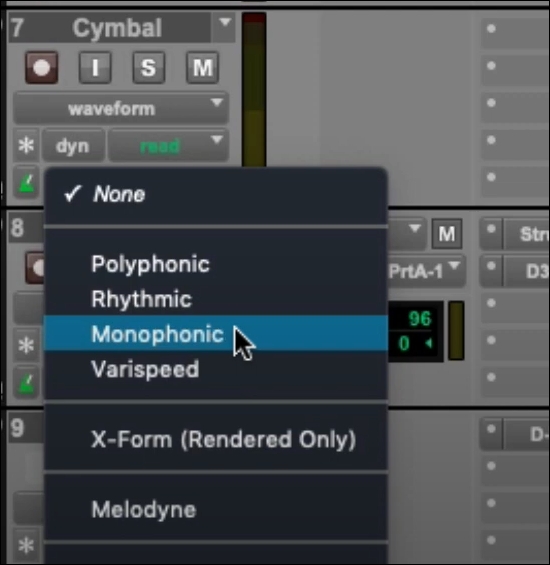
Step 3. Change the tempo.
Type in specific values in the Tempo box and get the MIDI controls visible at the top of the Edit window, if you don't see it, go to top of the Edit window and click the downward arrow at the upper right corner to check "MIDI Controls."
Share the five tempo-changing methods with Pro Tools users!
Tempo Track
Pro Tools also allows you to use a dedicated tempo track to automate tempo changes. This offers visual representation of tempo changes and allows for smooth tempo transitions using breakpoints. On the other side, it requires extra track space and may clutter the session if used extensively.
Step 1. Open the tempo editor.
Go to "Window" > "Tempo" to open the editor.
Step 2. Create tempo maps.
Enable the conductor. Draw in tempo changes using the Pencil tool or create tempo changes using breakpoints.

Step 3. Adjust the BPM.
You can adjust the tempo smoothly or make sudden changes, depending on your needs.

Change Tempo Online Quickly
While manual adjustments offer precision within Pro Tools, online tools provide swift solutions that are accessible from anywhere with an internet connection.
Among these, EaseUS Online Playspeed Changer stands out for its user-friendly interface and rapid tempo modifications. You can use it to find the key of a song first, then change the speed of a song from 0.5 to 1.5x for tempo change. The BPM number shows under the speed in real time.
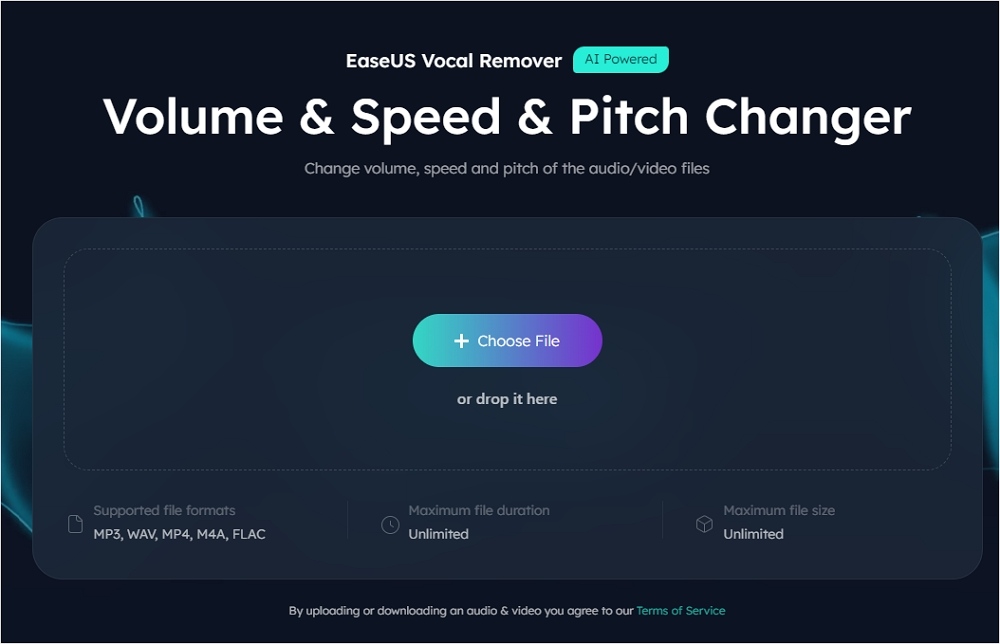
It supports multiple file formats, including MP3, WAV, MP4, M4A, and FLAC, and allows users to upload unlimited files without restrictions on the duration or size.
Key Features
- Change the pitch, volume, and speed online.
- Remove vocals from a song.
- Separate noise and instruments from audio.
- Find the key/BPM of a song.
Access the free tempo changer now:
How to adjust playback speed online:
Step 1. Enter the main interface of EaseUS Online Speed Changer. The left sidebar shows new functions of this online tool. Find "Pitch changer" and click it.
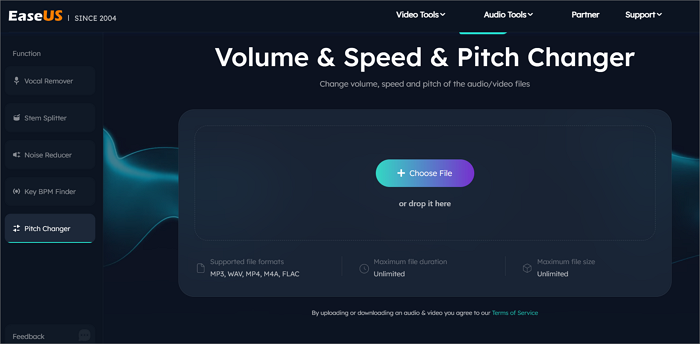
Step 2. Then, drop the audio/video file in the blank. It supports multiple file formats, including MP3, MP4, WAV, M4A, and FLAC.
Step 3. The website will analyze your file with AI. You can drag the little dot in the "Speed" section to slow down or speed up with a range of 0.5X to 1.5X.
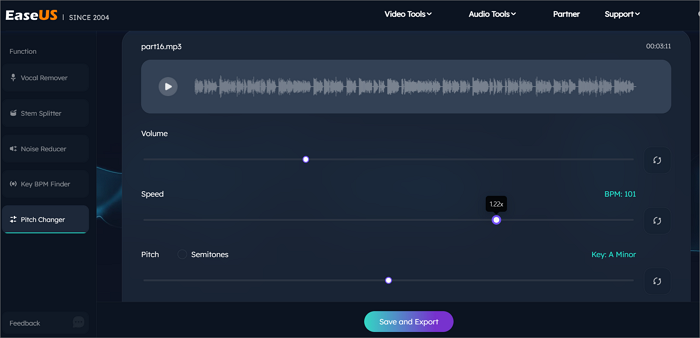
Step 4. Click "Save and Export" to download the processed file to your local file location.
Wrapping up
In conclusion, mastering the art of tempo manipulation in Pro Tools opens up endless creative possibilities for music producers, sound engineers, and content creators alike.
Whether you prefer the precision of manual adjustments or the convenience of automation, Pro Tools offers a variety of tools to suit your workflow.
Additionally, for those seeking quick and accessible solutions, online tools like EaseUS Online Playspeed Changer provide an efficient way to modify tempo on the go.
Change Tempo in Pro Tools FAQs
1. How do I change speed in Pro Tools?
To change speed in Pro Tools:
- Go up to the toolbar and click the left arrow icon.
- Select "TCE" for time compression.
- Drag the clip to the left or right and speed it up or slow it down.
2. What is the shortcut for BPM in Pro Tools?
To quickly access BPM change in Pro Tools, tap Option (Alt) + Numeric 2 on your board.
3. How do I map tempo in Pro Tools?
- Go to the edit window and find the "Tempo" ruler; if it isn't there, activate it by clicking the triangle button next to the "Bars Beats" box and checking it.
- Open the Tempo option, click the pencil icon from the menu bar, and draw tempos.
- Click on the selector tool and go up to "Events" > "Tempo Operations" > "Tempo Operations Window."
- Change the tempo value. You can use the trimmer tool to change the BPM.

